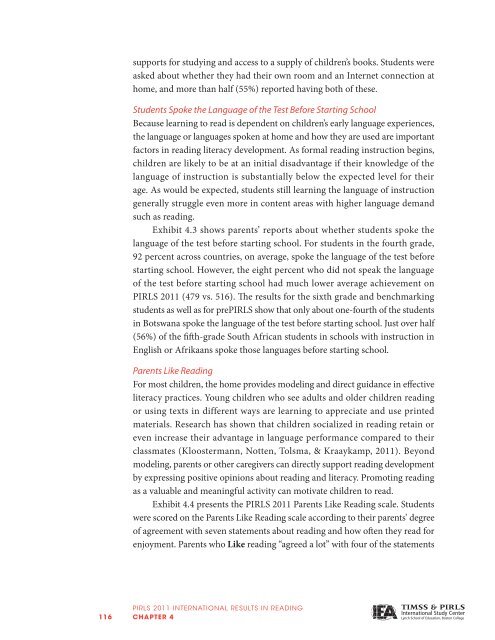Chapter 4 - TIMSS and PIRLS Home
Chapter 4 - TIMSS and PIRLS Home
Chapter 4 - TIMSS and PIRLS Home
Create successful ePaper yourself
Turn your PDF publications into a flip-book with our unique Google optimized e-Paper software.
supports for studying <strong>and</strong> access to a supply of children’s books. Students were<br />
asked about whether they had their own room <strong>and</strong> an Internet connection at<br />
home, <strong>and</strong> more than half (55%) reported having both of these.<br />
Students Spoke the Language of the Test Before Starting School<br />
Because learning to read is dependent on children’s early language experiences,<br />
the language or languages spoken at home <strong>and</strong> how they are used are important<br />
factors in reading literacy development. As formal reading instruction begins,<br />
children are likely to be at an initial disadvantage if their knowledge of the<br />
language of instruction is substantially below the expected level for their<br />
age. As would be expected, students still learning the language of instruction<br />
generally struggle even more in content areas with higher language dem<strong>and</strong><br />
such as reading.<br />
Exhibit 4.3 shows parents’ reports about whether students spoke the<br />
language of the test before starting school. For students in the fourth grade,<br />
92 percent across countries, on average, spoke the language of the test before<br />
starting school. However, the eight percent who did not speak the language<br />
of the test before starting school had much lower average achievement on<br />
<strong>PIRLS</strong> 2011 (479 vs. 516). The results for the sixth grade <strong>and</strong> benchmarking<br />
students as well as for pre<strong>PIRLS</strong> show that only about one-fourth of the students<br />
in Botswana spoke the language of the test before starting school. Just over half<br />
(56%) of the fifth-grade South African students in schools with instruction in<br />
English or Afrikaans spoke those languages before starting school.<br />
Parents Like Reading<br />
For most children, the home provides modeling <strong>and</strong> direct guidance in effective<br />
literacy practices. Young children who see adults <strong>and</strong> older children reading<br />
or using texts in different ways are learning to appreciate <strong>and</strong> use printed<br />
materials. Research has shown that children socialized in reading retain or<br />
even increase their advantage in language performance compared to their<br />
classmates (Kloostermann, Notten, Tolsma, & Kraaykamp, 2011). Beyond<br />
modeling, parents or other caregivers can directly support reading development<br />
by expressing positive opinions about reading <strong>and</strong> literacy. Promoting reading<br />
as a valuable <strong>and</strong> meaningful activity can motivate children to read.<br />
Exhibit 4.4 presents the <strong>PIRLS</strong> 2011 Parents Like Reading scale. Students<br />
were scored on the Parents Like Reading scale according to their parents’ degree<br />
of agreement with seven statements about reading <strong>and</strong> how often they read for<br />
enjoyment. Parents who Like reading “agreed a lot” with four of the statements<br />
<strong>PIRLS</strong> 2011 INTERNATIONAL RESULTS IN READING<br />
116 CHAPTER 4

















